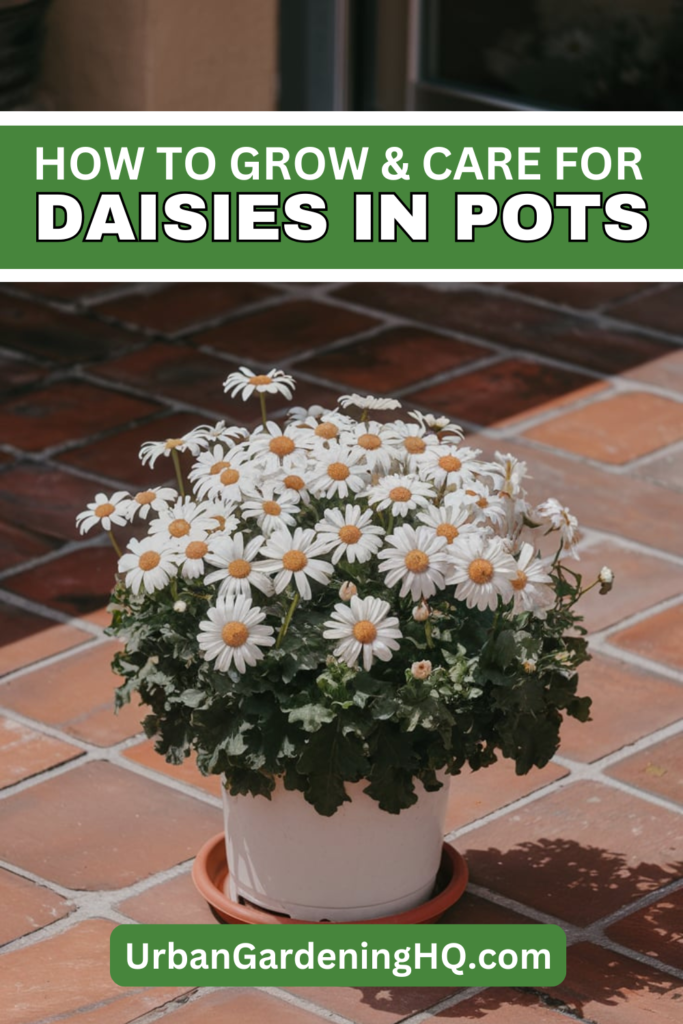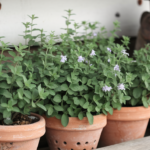There’s something undeniably cheerful about daisies. Their bright, simple blooms instantly add a touch of charm to any space, and the best part? They thrive in pots! Growing daisies in containers has been one of my favorite ways to bring a pop of color to my patio and balcony. They’re low-maintenance, long-blooming, and perfect for small spaces.
Over the years, I’ve learned the best methods for keeping potted daisies healthy, vibrant, and blooming for months. Let me walk you through everything I do to grow and care for daisies in pots, from choosing the right container to keeping them happy all season long.
Choosing the Right Pot and Soil

Picking the Perfect Pot
Daisies don’t have deep roots, but they do like room to spread, so I always go for a medium to large-sized pot—at least 12 inches wide and 10 inches deep.
Drainage is key! Daisies hate soggy roots, so I make sure the pot has multiple drainage holes. I often use terracotta pots because they allow extra moisture to evaporate, reducing the risk of root rot.
The Best Soil for Potted Daisies
Daisies thrive in light, well-draining soil. I use a good-quality potting mix, never heavy garden soil, which can compact too much in containers.
For the best results, I mix:
- 2 parts potting soil (for structure and nutrients)
- 1 part sand or perlite (for drainage)
- A handful of compost (for an extra boost of nutrients)
This mix keeps the roots happy by providing good airflow and preventing excess moisture buildup.
Planting Daisies in Pots
Starting with Seeds vs. Nursery Plants
While daisies can be grown from seeds, I usually start with nursery plants for faster results. Seeds take longer to mature, and I love having blooms sooner rather than later.
When planting, I:
- Fill the pot with my prepared soil mix.
- Dig a hole slightly larger than the plant’s root ball.
- Gently place the daisy plant in the hole, making sure the crown is level with the soil surface.
- Backfill with soil and press lightly to remove air pockets.
- Water thoroughly to help the roots settle.
If starting from seed, I scatter them on the soil surface, cover lightly, and keep the soil moist until germination (which takes about 10–21 days).
Sunlight and Placement
Daisies love the sun! To keep them blooming their best, I place my pots in a spot that gets at least 6 hours of direct sunlight daily.
If I’m growing them indoors, I keep them near a south-facing window or use a grow light during the winter. Without enough sun, daisies get leggy and produce fewer flowers.
Watering and Feeding Daisies
How I Water My Potted Daisies
Daisies prefer soil that’s moist but never soggy. Overwatering is one of the fastest ways to kill them, so I follow a simple rule:
- Check the top inch of soil—if it feels dry, it’s time to water.
- I water deeply until I see water draining from the bottom of the pot.
- I avoid watering the leaves to prevent fungal issues.
In the summer, I usually water every 2–3 days, but in cooler months, I cut back to once a week or less.
Fertilizing for More Blooms
To keep my daisies producing flowers, I fertilize every 4–6 weeks with:
- A balanced liquid fertilizer (like a 10-10-10 formula) diluted to half strength.
- A sprinkle of compost or worm castings in the soil for a natural nutrient boost.
I avoid high-nitrogen fertilizers since they encourage leafy growth instead of flowers.
Pruning and Deadheading for Continuous Blooms
Deadheading Daisies
To keep my daisies blooming for months, I remove spent flowers regularly. This process, called deadheading, encourages the plant to produce more blooms instead of seeds.
How I deadhead:
- I snip off faded flowers just above a set of healthy leaves using garden scissors.
- If the plant starts looking leggy, I trim back stems by a third to promote bushier growth.
Cutting Back After the Blooming Season
At the end of the season, I cut back the stems to about 3–4 inches above the soil. This helps the plant conserve energy for the next growing cycle.
Common Problems and How I Fix Them
Daisies are tough, but they can run into a few issues. Here’s how I handle the most common ones:
Yellowing Leaves
- Cause: Overwatering or poor drainage.
- Fix: I let the soil dry out before watering again and make sure the pot has good drainage.
Leggy Growth
- Cause: Not enough sunlight.
- Fix: I move the pot to a sunnier spot or trim the stems to encourage bushier growth.
Pests (Aphids & Spider Mites)
- Fix: I spray with a mild soapy water solution or use neem oil to keep pests away.
Powdery Mildew
- Fix: I improve airflow by spacing pots apart and avoid watering the leaves. A simple baking soda and water spray also helps control mildew.
Overwintering Potted Daisies
If I want to keep my daisies alive through winter, I take a few extra steps:
- For hardy daisies: I move the pot to a sheltered spot and mulch the soil for insulation.
- For tender varieties: I bring the pot indoors and place it in a cool, bright room until spring.
Daisies often go dormant in winter, so I reduce watering and stop fertilizing until the growing season returns.
Final Thoughts
Growing daisies in pots has been one of the easiest and most rewarding ways to brighten up my garden space. With plenty of sunlight, well-draining soil, and regular pruning, they bloom beautifully for months. Whether on a balcony, patio, or windowsill, daisies bring a cheerful touch wherever they grow.
If you haven’t tried growing them in pots yet, I highly recommend it! Do you grow daisies in containers? I’d love to hear your experiences and tips.


